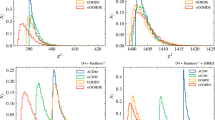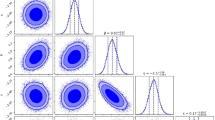Abstract
In the Friedmann cosmology, the deceleration of the expansion q plays a fundamental role. We derive the deceleration as a function of redshift q(z) in two scenarios: ΛCDM model and modified Chaplygin gas (MCG) model. The function for the MCG model is then fitted to the cosmological data in order to obtain the cosmological parameters that minimize χ 2. We use the Fisher matrix to construct the covariance matrix of our parameters and reconstruct the q(z) function. We use Supernovae Ia, WMAP5, and BAO measurements to obtain the observational constraints. We determined the present acceleration as q 0 = − 0.65 ±0.19 for the MCG model using the Union2 dataset of SNeIa, BAO, and CMB and q 0 = − 0.67 ±0.17 for the Constitution dataset, BAO and CMB. The transition redshift from deceleration to acceleration was found to be around 0.80 for both datasets. We have also determined the dark energy parameter for the MCG model: Ω X0 = 0.81 ±0.03 for the Union2 dataset and Ω X0 = 0.83 ±0.03 using the Constitution dataset.




Similar content being viewed by others
References
D. Larson, et al., arXiv:1001.4635 (2010)
A.G. Riess, et al., Astrophys. J. 607, 665 (2004)
A.G. Riess, et al., Astrophys. J. 659, 98 (2007)
C. Shapiro, M.S. Turner, Astrophys. J. 649, 563 (2006)
S. Nesseris, L. Perivolaropoulos, JCAP 7, 025 (2007)
J.V. Cunha, Phys. Rev. D 79, 047301 (2009)
E.E.O. Ishida, R.R.R. Reis, A.V. Toribio, I. Waga, Astropart. Phys. 28, 547 (2008)
M.C. Bento, O. Bertolami, A.A. Sen, Phys. Rev. D 66, 043507 (2002)
Z. Li, P. Wu, H.W. Yu, JCAP 9, 017 (2009)
H.B. Benaoum (2002). hep-th/0205140
U. Debnath, A. Banerjee, S. Chakraborty, Class. Quant. Grav. 21, 5609. arXiv:gr-qc/0411015 (2004)
M. Bouhmadi-Lopez, et al., Phys. Rev. D 81, 063504. arXiv:0910.5134 (2010)
P. Thakur, S. Ghose, B.C. Paul, Mon. Not. R. Astron. Soc. 397, 1935 (2009)
D.-J. Liu, X.-Z. Li, Chin. Phys. Lett. 22, 1600 (2005)
J. Lu et al., Phys. Lett. B 662, 87 (2008)
A. Kamenshchik, U. Moschela, V. Pasquier, Phys. Lett. B 511, 265 (2001)
N. Bilic, G.B. Tupper, R.D. Viollier, Phys. Lett. B 535, 17 (2002)
M.C. Bento, O. Bertolami, A.A. Sen, Phys. Rev. D 66, 043507 (2002); Phys. Rev. D 67, 063003 (2003)
M.C. Bento, O. Bertolami, A.A. Sen, Gen. Rel. Grav. 35, 2063 (2003)
M.L. Bedran, V. Soares, M.E. Araujo, Phys. Lett. B 659, 462 (2008)
F.C. Santos, M.L. Bedran, V. Soares, Phys. Lett. B 646, 215 (2007)
M. Makler, S.Q. de Oliveira, I. Waga, Phys. Lett. B 555, 1 (2003)
R. Amanullah, et al., ApJ 716, 712 (2010)
R. Kessler, et al., ApJ 185, 32 (2009)
M. Kowalski, et al., Astrophys. J. 686, 749 (2008)
M. Hicken, Astrophys. J. 700, 1097 (2009)
D.J. Eisenstein, et al., [SDSS Collaboration], Astrophys. J. 633, 560 (2005)
E. Komatsu, et al., arXiv:1001.4538 (2010)
U. Alam, et al., Mon. Not. R. Astron. Soc. 354, 275 (2004)
A. Heavens, arxiv:0906.0664v2 (2009)
M.P. Lima, S.D.P. Vitenti, M.J. Rebouças, Phys. Lett. B 668, 83 (2008)
W.J. Percival, et al., Mon. Not. R. Astron. Soc 381, 1053. arXiv:0705.3323 (2007)
B.A. Reid, Mon. Not. R. Astron. Soc 404, 60 arXiv:0907.1659 (2010)
Acknowledgements
A.M.V.T. would like to thank at project visiting professor of the Federal University of Juiz de Fora—Brazil.
Author information
Authors and Affiliations
Corresponding author
Rights and permissions
About this article
Cite this article
Velasquez-Toribio, A.M., Bedran, M.L. Fitting Cosmological Data to the Function q(z) from GR Theory: Modified Chaplygin Gas. Braz J Phys 41, 59–65 (2011). https://doi.org/10.1007/s13538-011-0012-7
Received:
Published:
Issue Date:
DOI: https://doi.org/10.1007/s13538-011-0012-7




